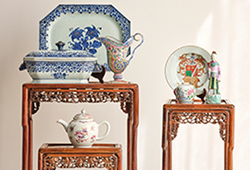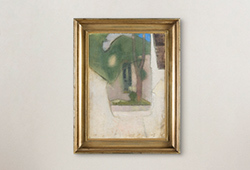Josef Frank
a Swedish Modern chintz covered oak cabinet, Svenskt Tenn Sweden, probably 1930s-1940s.
The fabric with a pattern of flower baskets in pink, green, white and brown against a light blue-green background, the interior with four adjustable shelves. Height 140 cm, width 120.5 cm, depth 40.5 cm.
Countess Elsa von Rosen's cabinet is probably a special commission of cabinet model no 522. The cabinet with model number 522 was designed in 1934-1935 and is of a considerably smaller size.
Already in Vienna in the early 1930s when working with Oscar Wlach and their company Haus & Garten Josef Frank began to cover cabinets with different kind of materials. At the time he made use of, like on this one, different kinds of fabrics.
After moving to Sweden Josef Frank designed the first cabinet covered with prints in 1938, it was the so called 'Flora cabinet'. Since then he designed several versions of covered cabinets, sometimes with different kinds of fabrics, sometimes with leather and also the ones covered with maps or plans. Key included.
Minor wear, a bit faded.
Provenance
Countess Elsa von Rosen (1904-1991), Princess Bernadotte 1937-1951.
Designer
Josef Frank was born in Austria and studied architecture in Vienna. As an architect, he worked with private home areas, villas and apartment buildings. In 1925 he started his own interior design firm Haus und Garten together with two architect colleagues. In connection with the advance of the Nazis, he emigrated to Sweden and was employed in 1934 at Svenskt Tenn. After the outbreak of World War II, Josef Frank, who came from a Jewish family, was forced into exile in New York. At Svenskt Tenn, he made an impact on the product range for four decades; especially when it comes to furniture and fabric prints.
Read more




























































































